Rural Scotland: key facts 2018
Biennial compendium publication comparing and contrasting statistics on key policy topics such as People and Communities, Services and Lifestyle, Economy and Enterprise broken down by Remote Rural, Accessible Rural and the Rest of Scotland.
This document is part of a collection
Economy and Enterprise
Industry
Figure 18: Employment in primary, secondary and tertiary sectors and in the public sector by geographic area, 2017
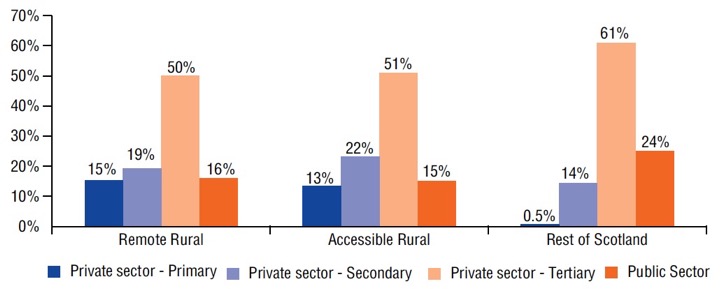
Source: Inter Departmental Business Register, as at March 2017 (Using Scottish Government Urban Rural Classification 2016)
Primary sector industries are defined as agriculture, forestry and fishing. Secondary industries include utilities, mining and quarrying; manufacturing and construction. Tertiary sector industries are made up of wholesale, retail and repair; accommodation and food services; transport, financial services, professional, technical and administrative services; education and health. The Public sector comprises central and local government.
Figure 18 shows employment in enterprises in Scotland registered for VAT and/or PAYE. In all areas in Scotland the tertiary sector is the largest in terms of employment, with at least half of employment in all areas of Scotland. Primary sector industries employ more people in remote rural areas (15%) and accessible rural areas (13%), than in the rest of Scotland (0.5%).
The Public sector accounts for 16% of employment in remote rural areas and 15% in accessible rural areas, whereas in the rest of Scotland the Public sector accounts for 24% of employment.
Figure 19: Employment by industry sectors and in the public sector by geographic area, 2017
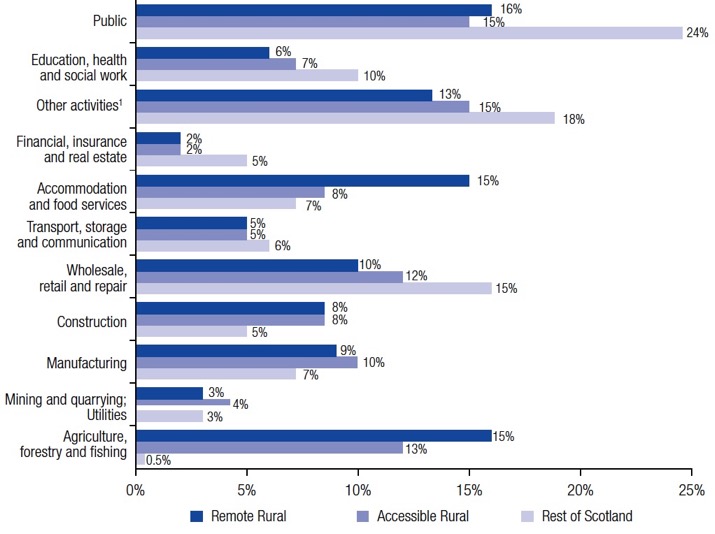
Source: Inter Departmental Business Register, as at March 2017 (Using Scottish Government Urban Rural Classification 2016)
Notes: 1. ‘Other activities’ consists of: ‘Professional, scientific and technical activities’, ‘Administrative and support service activities’ and ‘Arts, entertainment and recreation; Other service activities’.
Figure 19 shows the distribution of employment across sectors within each of the geographical areas, with workers in the Public sector shown as a single category. In all areas of Scotland the Public sector is the largest employing sector.
In remote rural areas the ‘Agriculture, forestry and fishing’ and ‘Accommodation and food services’ sectors are the largest source of private sector jobs (15%) followed by and ‘Other activities’ (13%). In accessible rural areas, ‘Other activities’ (15%), ‘Agriculture, forestry and fishing’ (13%), ‘Wholesale, retail and repair’ (12%) and Manufacturing’ (10%) are the largest sources of private sector jobs.
‘Agriculture, forestry and fishing’ is a sector that shows the greatest difference across Scotland, accounting for 15% of workers in remote rural areas compared to 13% in accessible rural areas and 0.5% in the rest of Scotland. Conversely, other sectors such as ‘Wholesale, retail and repair’ and ‘Financial, insurance and real estate’ are a larger source of jobs in the rest of Scotland than in rural areas.
Business
Figure 20: Employment by size of firm and geographic area, 2017
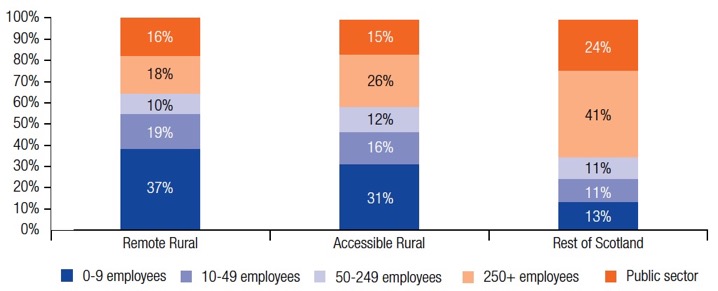
Source: Inter Departmental Business Register, as at March 2017 (Using Scottish Government Urban Rural Classification 2016)
Figure 20 shows that Small and Medium Enterprises (0-249 employees) account for two thirds of businesses in remote rural areas compared to 59% in accessible rural areas and just over a third in the rest of Scotland. Micro businesses (0-9 employees) are particularly prevalent in remote rural and accessible rural areas (37% and 31% respectively). This compares to only 13% in the rest of Scotland.
Large businesses (250+ employees) account for 41% of those employed in the rest of Scotland, 26% in accessible rural areas and 18% in remote rural areas.
Table 25: Percentage of small and medium enterprises by industry sector and geographic area, 2017
Remote Rural |
Accessible Rural |
Rest of Scotland |
|
|---|---|---|---|
Agriculture, forestry and fishing |
35% |
27% |
2% |
Mining and quarrying; Utilities |
1% |
1% |
1% |
Manufacturing |
5% |
5% |
5% |
Construction |
10% |
11% |
11% |
Wholesale, retail and repair |
10% |
10% |
15% |
Transport, storage and communication |
5% |
7% |
10% |
Accommodation and food services |
8% |
5% |
8% |
Financial, insurance & real estate |
2% |
3% |
5% |
Other activities1 |
21% |
29% |
36% |
Education, health & social work |
3% |
3% |
6% |
Public |
0% |
0% |
0% |
Total |
100% |
100% |
100% |
Source: Inter Departmental Business Register, as at March 2017 (Using Scottish Government Urban Rural Classification 2016)
Notes: 1. ‘Other activities’ consists of: ‘Professional, scientific and technical activities’, ‘Administrative and support service activities’ and ‘Arts, entertainment and recreation; Other service activities’
Table 25 shows in which industry sectors Small and Medium Enterprises (SMEs) operate, across all three geographic areas. In remote rural areas, 35% of SMEs are in the ‘Agriculture, forestry and fishing’ sector, compared to 27% in accessible rural areas and 2% in the rest of Scotland. The ‘Other activities’ sector represent 36% of SMEs in the rest of Scotland compared to 29% of SMEs in accessible rural areas and 21% of SMEs in remote rural areas.
The total number of SMEs (registered for VAT and/or PAYE) operating in remote rural areas, accessible rural areas and the rest of Scotland as at March 2017 were 19,470, 28,800 and 126,840 respectively.
Table 26: Population (16 to 74) in employment by socio-economic classification by geographic area, 2017
Remote Rural |
Accessible Rural |
Rest of Scotland |
|
|---|---|---|---|
Higher managerial and professional occupations |
11% |
17% |
16% |
Lower managerial and professional occupations |
23% |
27% |
28% |
Intermediate occupations |
11% |
11% |
15% |
Small employers and own account workers |
18% |
14% |
8% |
Lower supervisory and technical occupations |
12% |
10% |
8% |
Semi-routine occupations |
14% |
13% |
15% |
Routine occupations |
11% |
9% |
11% |
Total |
100% |
100% |
100% |
Source: Annual Population Survey in Scotland, January to December 2017 (using the Scottish Government Urban Rural Classification 2016)
There are a higher proportion of people living in accessible rural areas (17%) and in the rest of Scotland (16%) that are employed in higher managerial and professional positions compared to remote rural areas (11%). There are a similar pattern for those employed in lower managerial and professional occupations but the proportions in all areas of Scotland are all roughly ten percentage points higher than higher managerial and professional positions.
A greater proportion of workers in remote rural areas (18%) are small employers or own account workers than in accessible rural areas (14%) or the rest of Scotland (8%).
Table 27: Business openings and closures by geographic area, 2016
Remote Rural |
Accessible Rural |
Rest of Scotland |
|
|---|---|---|---|
Total businesses |
14,865 |
26,655 |
136,915 |
Business openings |
1,300 |
2,785 |
18,185 |
Business opening rate |
9% |
10% |
13% |
Business closures |
1,270 |
2,550 |
17,160 |
Business closure rate |
9% |
10% |
13% |
Total businesses per 10,000 adults |
471 |
446 |
305 |
Business openings per 10,000 adults |
41 |
47 |
40 |
Net business openings and closures |
30 |
235 |
1,025 |
Net business openings and closures as % of total businesses |
0.2% |
1% |
1% |
Source: Inter Departmental Business Register (ONS) 2016 (Using Scottish Government Urban Rural Classification 2016)
Table 27 shows the number of business openings and closures as measured by the number registering for either VAT or PAYE. It therefore excludes businesses with no employees and a turnover below the VAT threshold (£83,000 as at 1st April 2016).
All areas of Scotland showed an increase in the number of active businesses over the last year. The lowest rate of business openings was seen in remote rural areas (9%), with the highest in the rest of Scotland (13%). Business closure rates were also lowest in remote rural areas (8%) and highest in the rest of Scotland (13%).
The net business openings and closures as a percentage of total businesses was 1% in both accessible rural areas and the rest of Scotland. It was lower at 0.2% in remote rural areas, a net increase of only 30 businesses.
The Scottish Government has a National Indicator[7] to increase the number of businesses.
Economic Activity
Figure 21: Economic activity of population aged 16 to 64 by geographic area, 2017
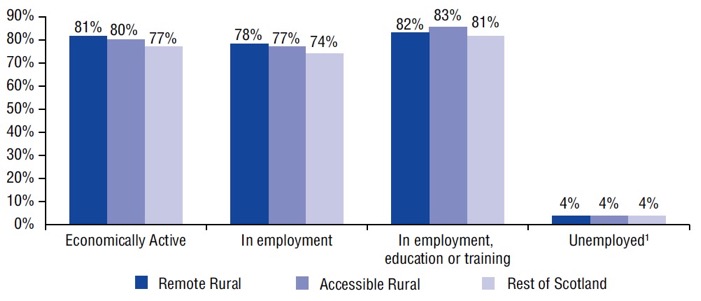
Source: Annual Population Survey in Scotland, January to December 2017 (Using the Scottish Government Urban Rural Classification 2016)
Notes: 1. The unemployment rate is based on the proportion of the population aged 16 to 64 who are economically active. This differs from the other rates in the figure, which are based on the whole population aged 16 to 64. It also differs from the standard International Labour Organisation of definition of unemployment, which is the number of adults (aged 16 and over) expressed as a proportion of adults who are economically active.
Figure 21 shows that all indicators of economic activity are highest in rural Scotland. The economic activity rate (people employed or looking for work), employment rate (the number of people employed as a percentage of the total population of working age) and the rate of working age population that is either employed, in education or training are all higher in rural areas than in the rest of Scotland.
Unemployment rates are the same across all areas of Scotland at 4%.
The total number of people employed in remote rural areas, accessible rural areas and the rest of Scotland are 146,900, 303,700 and 2,082,800 respectively.
Figure 22: Employment rates by geographic area, 2017
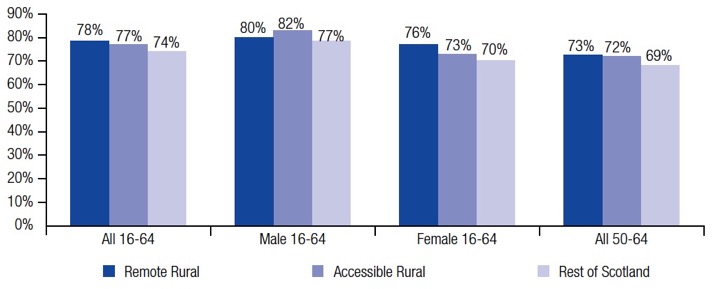
Source: Annual Population Survey in Scotland, January to December 2017 Using the Scottish Government Urban Rural Classification 2016
Figure 22 shows that the employment rates are higher for all sub-groups in rural areas compared to the rest of Scotland. Within rural areas, remote rural areas have the highest employment rates for all sub-groups, apart from males aged 16 to 64 where the employment rate is higher in accessible rural areas.
The highest employment rates in all areas of Scotland are for males aged 16 to 64, with the highest rate being 82% in accessible rural areas followed by 80% in remote rural areas. In the rest of Scotland, the employment rate for males aged 16 to 64 is 77%.
Table 28: Patterns of work1 by geographic area, 2017
Remote Rural |
Accessible Rural |
Rest of Scotland |
|
|---|---|---|---|
Percentage of Employed Males who are: |
|||
Self-employed |
28% |
22% |
14% |
Working part time in main job |
15% |
11% |
12% |
With a second job |
6% |
3% |
3% |
Homeworkers2 |
28% |
22% |
11% |
Percentage of Employed Females who are: |
|||
Self-employed |
16% |
14% |
7% |
Working part time in main job |
46% |
45% |
42% |
With a second job |
6% |
6% |
4% |
Homeworkers2 |
19% |
14% |
7% |
Percentage of All employed who are: |
|||
Self-employed |
23% |
18% |
11% |
Working part time in main job |
29% |
27% |
27% |
With a second job |
6% |
4% |
3% |
Homeworkers2 |
24% |
18% |
9% |
Source: Annual Population Survey in Scotland, January to December 2017 (Using Scottish Government Urban Rural Classification 2016)
Notes: 1. Includes all workers aged 16 and over. 2. Homeworkers are people who work mainly in their own home, or in different places using home as a base, in their main job. Excludes people on government employment and training schemes.
Table 28 shows that self-employment is around twice as common in rural Scotland as in the rest of Scotland. In all areas of Scotland, men are more likely to be self-employed than women. Of employed males in remote rural areas, 28% are self-employed.
Women are considerably more likely than men to work part time in all areas of Scotland, with over 40% of women who are employed working part time in all areas of Scotland.
The percentage of employed people in remote rural areas who have a second job (6%) is double that of employed people in in the rest of Scotland (3%).
In accessible rural areas, double the proportion of employed people are ‘homeworkers’ compared to the rest of Scotland. The difference is even larger when the rest of Scotland is compared to remote rural areas. A homeworker is someone who works mainly in their own home or uses their home as a base.
Earnings
Figure 23: Residence based median hourly rates of pay1 by geographic area, 2017
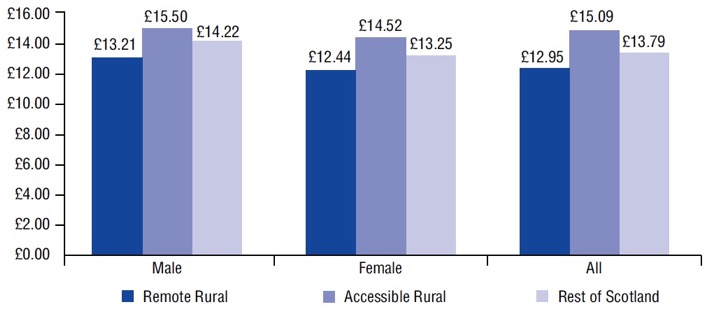
Source: Annual Survey of Hours and Earnings 2017 (Using the Scottish Government Urban Rural Classification 2016)
Notes: 1. Employees on adult rates whose pay for the survey pay-period was not affected by absence.
Figure 23 shows the median hourly wage rate for all male and female employees residing in each of the geographical areas. In all areas of Scotland, the median wage for males is higher than that for females. The median wage of those who reside in accessible rural areas is highest for both males and females.
The differences in median hourly rates of pay between the different areas are greater for males than females. The largest difference is between males who reside in accessible rural and remote rural areas (£2.29 higher per hour in accessible rural areas).
Table 29: Residence based median gross annual pay for full-time employees1 by geographic area, 2017
Remote Rural |
Accessible Rural |
Rest of Scotland |
|
|---|---|---|---|
Male |
£29,229 |
£32,923 |
£30,228 |
Female |
£24,934 |
£27,503 |
£25,243 |
All |
£27,188 |
£30,985 |
£28,122 |
Source: Annual Survey of Hours and Earnings 2017 (Using Scottish Government Urban Rural Classification 2016)
Notes: 1. Employees on adult rates who have been in the same job for more than a year.
Table 29 shows that the median gross annual pay (i.e. before taxation and other deductions) for all full-time employees is highest for people living in accessible rural areas. This is followed by people living in the rest of Scotland and then finally those residing remote rural areas.
In all areas of Scotland, the median gross annual pay is higher for males than females but the disparity in median pay is also greater for males than for females.
Income
Figure 24: Annual net income of highest income householder by geographic area, 2017
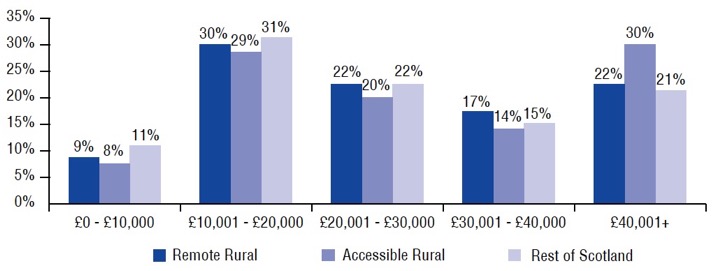
Source: Scottish Household Survey 2017 (Using Scottish Government Urban Rural Classification 2016)
Figure 24 presents the distribution of net household income figures (for the highest income householder) by geographic area. The income figures include income from employment, benefits and other sources (after taxation and other deductions).
The most common income bracket for a household to fall into in remote rural areas and the rest of Scotland is the £10,001 to £20,000 category, while in accessible rural areas it is the £40,001 and over category.
There is also a marked difference between the proportion of households in the £40,001 and over category in accessible rural areas (30%), compared to remote rural areas and the rest of Scotland (22% and 21% respectively).
Table 30: Income and employment deprivation by geographic area, 2016
Remote Rural |
Accessible Rural |
Rest of Scotland |
|
|---|---|---|---|
Number income deprived |
26,240 |
44,900 |
588,780 |
Number employment deprived |
13,305 |
24,915 |
331,440 |
Percentage of the population that are income deprived |
8% |
8% |
13% |
Percentage of the working age1 population that are employment deprived |
7% |
7% |
11% |
Source: Scottish Index of Multiple Deprivation 2016 (Using 2014 mid-year population estimates (NRS) and Scottish Government Urban Rural Classification 2016 Notes: 1. For males, working age refers to population aged 16 to 64. For females the working age population is transitioning from 60 to the same age as males. For this indicator the working age of females is taken as at 30 June 2014 as defined by the Pensions Act 2014. Further information on the Pensions Act 2014 can be accessed here: https://www.gov.uk/government/collections/pensions-bill
Income deprivation comprises six indicators including being in receipt of Income Support or Employment and Support Allowance, Job Seekers Allowance, Working and Child Tax Credits and Guaranteed Pension Credit.
Employment deprivation comprises three indicators that identify those people that want to work, but due to unemployment, ill health or disability are excluded from the labour market. The indicators used are Unemployment Claimant Count, Incapacity Benefits or Employment and Support Allowance and Severe Disablement Allowance.
Table 30 shows that the percentage of the total population that is income deprived is lower in rural areas than the rest of Scotland.
The percentage of the working age population, as defined by the Scottish Index of Multiple Deprivation, that are employment deprived is also lower in rural areas than in the rest of Scotland.
Contact
Neil Henderson: RuralStatistics@gov.scot
There is a problem
Thanks for your feedback